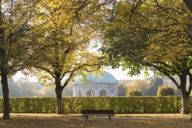
The Hofgarten (Royal Garden) at the Residenz palace is an idyllic green park on the edge of Munich’s historic old town.
The Hofgarten has remained the same size since the early 17th century: Elector Maximilian I had the gardens created on the basis of a model Italian Renaissance garden between 1613 and 1617. Back then, however, only dukes and electors were permitted to stroll here. It was not until 1780 that Elector Karl Theodor opened the gardens to the public.
Impressive arcade-style passages surround the Hofgarten: The northern arcade runs along Galeriestrasse, which is home to buildings such as the Deutsche Theatermuseum (German Theatre Museum), offering visitors an outstanding insight into the world of German theatre. The western arcade follows Ludwigstrasse and contains frescos by the pupils of painter Peter Cornelius.
At the centre of the park, you will find a pavilion, popularly known as Diana Temple. The delicate, dodecagonal pavilion, which features eight entrance archways, was created by Heinrich Schön the Elder in 1615. The roof features a copy of the bronze “Tellus Bavaria” statue by Hubert Gerhard, which represents the riches of Bavaria: water, crops, salt and game. The original version now stands in the Theatiner arcade at the Residenz palace, perfectly protected from the elements.
The Hofgarten and its comfortable park benches are the ideal place to relax. If you fancy it, you can watch a few exciting rounds of boules, which are played out on the side gravel paths, or the tango dancers, who meet here on warm summer evenings. With a little luck you may even catch one of the spontaneous concerts in the pavilion – which are normally of the classical variety.
Right beside it, you can also visit the Munich Residenz, the largest inner-city palace in Germany. From here, the Bavarian rulers have guided the fortunes of their subjects since 1508.